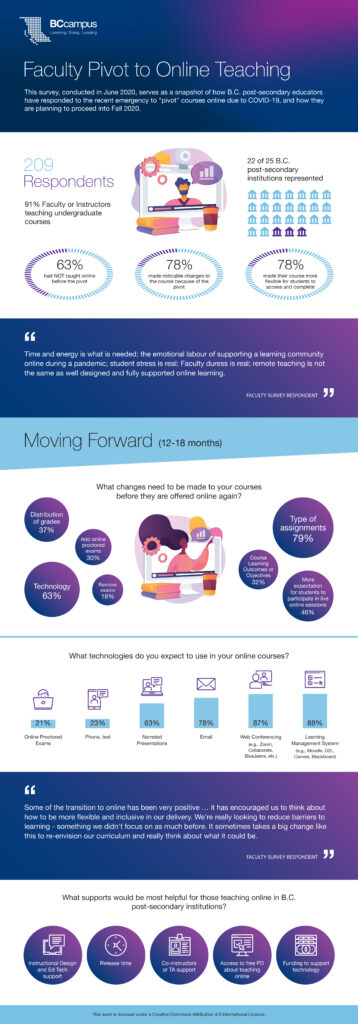One positive thing we noticed during the COVID-19 pandemic was how quickly and effectively everyone came together to support teaching and learning across the province. In a survey conducted in May–June 2020, we asked B.C. faculty to share their approaches to the pivot to online learning.
Post by BCcampus’ editorial team
To help shape our immediate and ongoing responses, the teams at BCcampus wanted to get a better sense of what B.C. post-secondary educators were doing about conversion to and creation of online learning environments. With a phenomenal response, representing 22 of the 25 post-secondary institutions in B.C., we compiled this snapshot of where we were at during that stage of the pandemic and what’s in store for the months to come.
The Data
Of the 209 people who submitted responses to our survey, 91 per cent identified as a faculty member, associate faculty member, instructor, sessional instructor, or teaching assistant. Librarians made up 2 per cent of the respondents, and those working as an educational developer, instructional designer, faculty developer, or learning designer comprised another 2 per cent.
Here are some quick facts from the survey:
- 63 per cent of respondents had never taught online before the pivot.
- 78 per cent described the changes made to their course as several and/or significant.
- 46 per cent tried to make their course as similar as possible to their F2F model, and 39 per cent stripped the course back to the bare minimum, removing some readings and assignments.
- 44 per cent leaned heavily on their learning management systems (LMS) to conduct their courses, and 32 per cent said they relied primarily on web conferencing tools — such as Zoom, BlueJeans, Teams, and Big Blue Button — to continue their teachings.
- 68 per cent believe that, over the next 12–18 months, they’ll be teaching the same course they pivoted to in the pandemic. 65 per cent expect they’ll be teaching a different course that will need to change for online delivery.
Preparing for the Future
Moving forward, respondents shared what future courses could — or should — look like:
- 79 per cent said that the types of assignments used will need to change before the course can run.
- 63 per cent believe that the technology needs to change.
- 46 per cent feel that there will be higher expectations of students to participate in live online sessions.
- 37 per cent expect changes in the distribution of grades.
- 32 per cent see changes in the course learning outcomes or objectives.
- 30 per cent foresee the addition of online proctored exams.
- 18 per cent think exams need to be removed.
- 6 per cent believe that no changes are required — courses can run as is.
- Web conferencing, LMS, email, and narrated presentations were all tagged as technologies that will be used in future online courses, as were online proctored exams and phone/text options.
- 57 per cent of respondents believe that more access to instructional/learning design support and more access to educational technology support will be most helpful for those teaching online courses in B.C.
- 56 per cent would like more release time for teaching.
- 49 per cent would like more help integrating free and open educational resources into their courses.
- 48 per cent would like access to free professional development for teaching online.
- 33 per cent want teaching assistance or other instructional support.
Better Together
“We’re all in the same storm, just in different ships,” explained Anne Sommerfeld, co-chair of the B.C. Teaching & Learning Council (BCTLC). “In the early days of the pivot to online learning, many of us felt that we were failing our students and educators, but through sharing, collaborating, and conversing with each other, we learned that we’re not doing so bad in our boats, and together, we can weather the storm. For faculty, the anxiety of not knowing, not being sure, is the hardest part. As leadership at the BCTLC, we are facilitating conversations to find out how each group is handling the obstacles, so we can bring consistency to the message and share it throughout the teaching and learning community.”
“As we made the pivot,” shared Paula Hayden, co-chair for BCTLC, “every teaching and learning centre across B.C. was tapped into in a very deliberate and high demand kind of way, especially around technology. Generally, our people are comfortable with their approach to teaching, but the urgency to make the pivot and use technology was a big, big deal. Students are always the ultimate focus, so we do whatever we can to make accessing learning easy and effective for students.”
Notable Quotes
“One great resource for our educators and institutions was BCNET — they support many of the tech solutions while doing the legwork around privacy concerns and connectivity issues.”
—Paula Hayden, co-chair, British Columbia Teaching & Learning Council
“Some of the transition to online has been very positive […] It has encouraged us to think about how to be more flexible and inclusive in our delivery. We’re really looking to reduce barriers to learning — something we didn’t focus on as much before. It sometimes takes a big change like this to re-envision our curriculum and really think about what it could be.”
—BCcampus survey respondent
Check out this infographic on the faculty pivot to online teaching for a visual representation of the survey’s findings.

